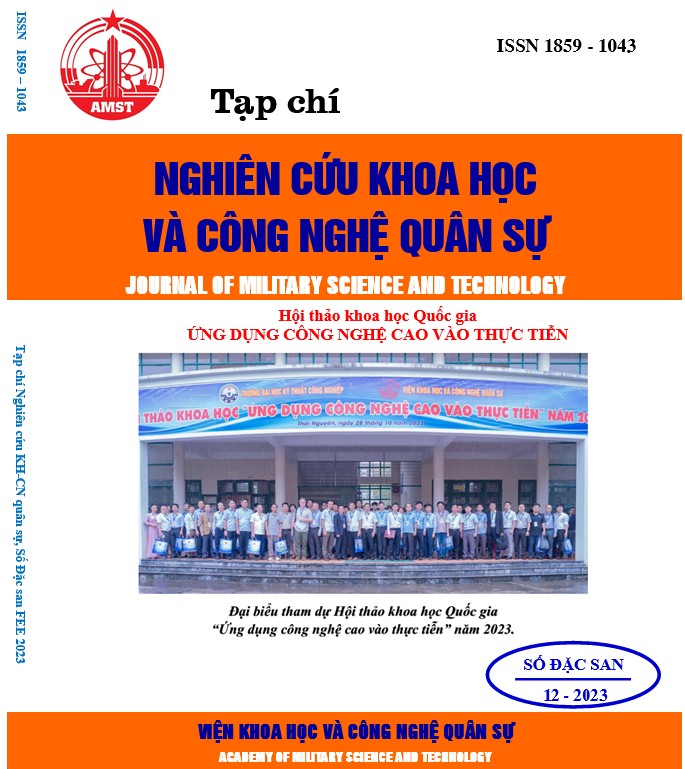Modeling and simulation of vestibular-ocular reflex system for medical applications
307 viewsKeywords:
Vestibulo-Ocular Reflex - VOR; Vestibular disorder; Dizziness-imbalance; Video head impulse test.Abstract
In this article, the authors propose a new vestibulo-ocular reflex (VOR) model and a method for optimizing the parameter set of this model for each individual. The proposed method is based on eye-tracking devices. The method involves determining the center of the pupil based on estimating the pupil contour and the geometric estimation of the ellipse center. The suggestion is to measure the angle of rotation and the angular velocity based on the spatial geometry of pixel image size and frame capture rate. The proposed methods are evaluated using Matlab tools. The proposed VOR model is useful for healthcare professionals in making diagnostic decisions and providing effective examination and treatment solutions for patients.
References
[1]. Kandel, E. R.. Schwartz, J. H and Thomas M. Jessell, “Principles of Neural Science: 5th edition,” McGraw-Hill Education / Medical, (2012).
[2]. Agrawal, Y., Van de Berg, R., Wuyts, F., Walther, L., Magnusson, M., Oh, E., Sharpe, M., & Strupp, M., “Presbyvestibulopathy: Diagnostic criteria Consensus document of the classification committee of the Bárány Society,” Journal of vestibular research: equilibrium & orientation, Vol. 29, No. 4, pp.161–170, (2019).
[3]. D. M.Merfeld and L. H. Zupan, “Neural processing of gravitoinertial cues in humans. III. Modeling tilt and translation responses,” Journal of Neurophysiology, Vol. 87, No. 2, pp.819–833, (2002).
[4]. L. H. Zupan and D. M. Merfeld, “Neural processing of gravito-inertial cues in humans. IV. Influence of visual rotational cues during roll optokinetic stimuli,” Journal of Neurophysiology, Vol. 89, No. 1, pp.390–340, (2003).
[5]. J. L. Viirre, and E. S. Demer, “Visual-Vestibular Interaction During Standing, Walking, and Running,” Journal of Vestibular Research, Vol. 6, No. 4, pp.295-313, (1996).
[6]. D. A. Robinson, “The use of control systems analysis in the neurophysiology of eye movements,” Annual Review of Neuroscience, Vol. 4, pp.463–503, (1981).
[7]. Anh Son Le, Makoto Inagami, Hiroto Hamada, Tatsuya Suzuki, Hirofumi Aoki, “Towards online detection of driver distraction: Eye-movement simulation based on a combination of vestibulo–ocular reflex and optokinetic reflex models,” Transportation Research Part F: Traffic Psychology and Behaviour, Vol. 65, pp. 716-729, (2019).
[8]. K. Kabaya, S. Katsumi, A. Fukushima, S. Esaki, T. Minakata and S. Iwasaki, “Assessment of semicircular canal function in benign paroxysmal positional vertigo using the video head impulse test and caloric test,” Laryngoscope Investigative Otolaryngology, Vol. 8, No. 2, pp.525-531, (2023).
[9]. G. Psillas, I. Petrou, A. Printza, I. Sfakianaki, P. Binos, S. Anastasiadou and J. Constantinidis, “Video head impulse test (vHIT): value of gain and ascending fixation in vestibular neuritis one side,” Journal of Clinical Medicine, Vol. 11, No. 12, pp. 1-11, (2022).
[10]. Jennifer L Millar, Yoav Gimmon, Dale Roberts, Michael C Schubert “Improvement After Vestibular Rehabilitation Not Explained by Improved Passive VOR Gain,” Frontiers in Neurology, Vol. 11:79 (2020).
[11]. Jin N, Mavromatis S, Sequeira J, Curcio S. “A Robust Method of Eye Torsion Measurement for Medical Applications,” Information, Vol. 11, No. 9, pp. 1-15, (2020).
[12]. F. Donders, “On the Anomalies of Accommodation and Refraction of the Eye,” The New Sydenham Society: London, UK, ISBN 074531807X, (1864).







